No Wires Needed 10410208 WLAN Access Point User Manual MANUALV0 4
No Wires Needed WLAN Access Point MANUALV0 4
Contents
- 1. product brochure
- 2. user manual
user manual
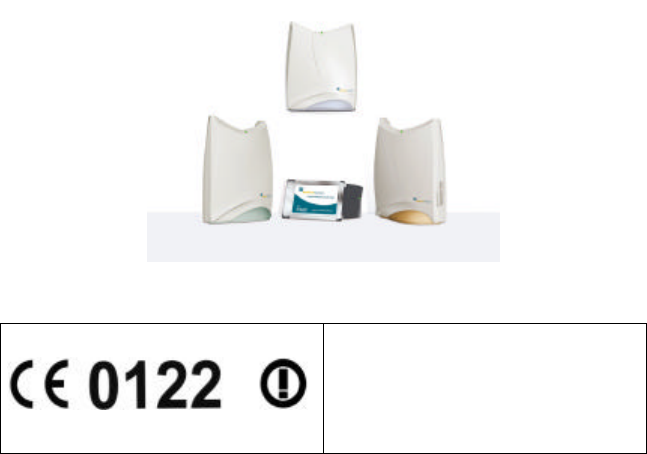
No Wires Needed
11 Mbps WLAN Access Point
User Manual
Version 3.0.1 – March 2000
Important Notice
This device is a 2.4 GHz low power
Access Point transceiver intended for
use in all EU memberstates, except for
France where restrictive use applies.
Please refer to page 9 of this manual for
further details.
User manual
11Mbps WLAN Access Point
No Wires Needed
Rembrandtlaan 1a
3723 BG Bilthoven
The Netherlands
www.nwn.com
Version 3.0.1 – March 2000
Trade marks
Copyright © No Wires Needed
The publisher reserves the right to revise this publication and to make
changes to any or all parts of this manual at any time, without obligation to
notify any person or entity of such revisions or changes.
AirLock, APCenter, ASBF and Connect are trademarks of No Wires Needed.
Other product and company names are registered trademarks or trademarks
of their respective holders.
Copyright statement
No part of this publication may be reproduced, stored in a retrieval system, or
transmitted in any form or by any means, whether electronic, mechanical,
photocopying, recording, or otherwise without the prior writing of the publisher.
Printed in Velp, March 2000
Free Repair Period
NWN undertakes a Free Repair Period of 12 months from the date of Invoice.
Within the Free Repair Period NWN repairs a faulty device free of charge or
replaces it in case of irreparable damage.
Excluded from the Free Repair Period are malfunctions caused by operation
outside the intended usage; by misuse or abuse; by service modifications or
repairs performed by unauthorized persons or by other conditions not arising
from defects in Product materials or workmanship.
The costs associated with physically replacing the defective part and re-
installing is to be borne by the Buyer.
R&TTE Compliance Statement
This equipment complies with all the requirements of the DIRECTIVE
1999/5/EC OF THE EUROPEAN PARLIAMENT AND THE COUNCIL of 9
March 1999 on radio equipment and telecommunication terminal Equipment
and the mutual recognition of their conformity (R&TTE).
The R&TTE Directive repeals and replaces in the directive 98/13/EEC
(Telecommunications Terminal Equipment and Satellite Earth Station
Equipment) As of April 8, 2000.
Safety
This equipment is designed with the utmost care for the safety of those who
install and use it. However, special attention must be paid to the dangers of
electric shock and static electricity when working with electrical equipment. All
guidelines of this manual and of the computer manufacturer must therefore be
allowed at all times to ensure the safe use of the equipment.
Restriction of use
The channel use of this Access Point differs regulatory domain. Please check
if the regulatory domain mentioned on the sticker on the box and mentioned in
APcenter fits your country. Please refer to chapter 4.5 for reading regulatory
domain out of the Access point and to chapter 4.9 for the list of regulatory
domains.
Using an Access Point with illegal regulatory setting creates a possibility of
transmitting on channels that are not allowed by the government. If for some
reason the regulatory domain is not correct, do not install your access point
and contact immediate your Reseller.
Intended use
This product is a low power 2.4 GHz WLAN Access Point transceiver intended
for home and office use.
EU Countries intended for use
The ETSI version of this device is intended for home and office use in Austria,
Belgium, Denmark, Finland, France (with Frequency channel restrictions),
Germany, Greece, Ireland, Italy, Luxembourg, The Netherlands, Portugal,
Spain, Sweden and United Kingdom.
The ETSI version of this device is also authorized for use in EFTA member
states Iceland, Liechtenstein, Norway and Switzerland.
EU Countries Not intended for use
None.
Potential restrictive use
France: Only channels 10,11,12, and13
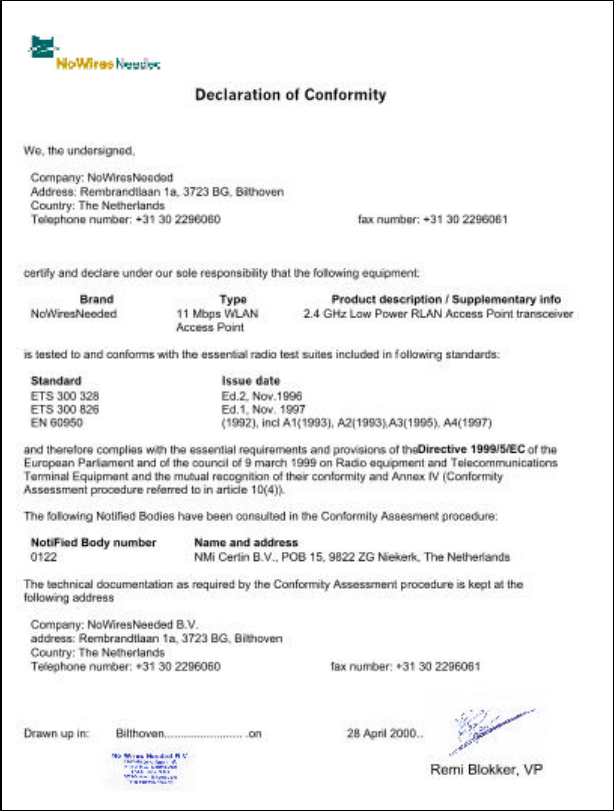
RTTE Declaration of conformity

FCC Radiation Exposure Statement
This equipment complies with FCC radiation exposure limits set forth for an
uncontrolled environment. This equipment should be installed and operated
with the minimum distance between your body, excluding hands, wrists, feet
and ankles, and the antenna as shown in the table below:
Access Points which use the internal low
gain indoor antennas (1.9dBi) 20cm (7 inches)
Declaration of Conformity FCC
This device complies with Part 15 of the FCC Rules. Operation is subject to
the following two conditions: (1) this device may not cause harmful
interference, and (2) this device must accept any interference received,
including interference that may cause undesired operation.
No Wires Needed 11 Mbps
WLAN Access Point
Tested To Comply
With FCC Standards
FOR HOME OR OFFICE USE

No Wires Needed
Page 10 of 40 11 Mbps WLAN Access Point User manual
1 Contents
1 Contents ............................................................................................10
2 Introduction........................................................................................11
3 Installation .........................................................................................12
4 APCenter™ Features .........................................................................15
4.1 Starting APCenter for the first time ..............................................16
4.2 APCenter™ Main Window ..........................................................23
4.3 Quick Start to Wireless Networking .............................................25
4.4 Managing WLANs.......................................................................26
4.5 Managing Access Points.............................................................27
4.5.1 Network Settings Dialog ......................................................29
4.5.2 Searching for Access Points................................................30
4.5.3 Manually programming IP addresses...................................31
4.6 Managing Security......................................................................32
4.6.1 Access Control....................................................................33
4.7 Updating Access Point Settings...................................................35
4.8 AirLock™ Security Architecture...................................................36
4.9 More about Cells ........................................................................36
4.10 Compatibility...............................................................................37
5 Glossary ............................................................................................38
6 Technical specifications 11 Mbps Wlan...............................................39
6.1 Standards supported ..................................................................39
6.2 Environmental ............................................................................39
6.3 Power specifications...................................................................39
6.4 Radio specifications....................................................................40
6.5 Specific features.........................................................................40
6.6 Physical Dimensions...................................................................40

No Wires Needed
User Manual 11 Mbps Wlan Access Point Page 11 of 40
2 Introduction
Thank you for purchasing your No Wires Needed 11 Mbps WLAN Access
Point. This manual will assist you with the installation procedure.
The package you have received should contain the following items:
• User manual
• 11 Mbps WLAN Access Point
• Mounting material
• Power adapter
• CD containing APCenter™ Software
Note: if anything is missing, please contact your vendor
A wireless LAN is normally used in a predefined environment. In such a
network, Access Points are mounted at assigned places, each covering its
own area in which wireless nodes can operate. These Access Points are
connected to a wired network to communicate with each other and with
servers and clients on that network.
The 11 Mbps Wlan Access Point can be connected to a 10 or 100 Mbps
Ethernet network through a RJ45 (UTP) connector.
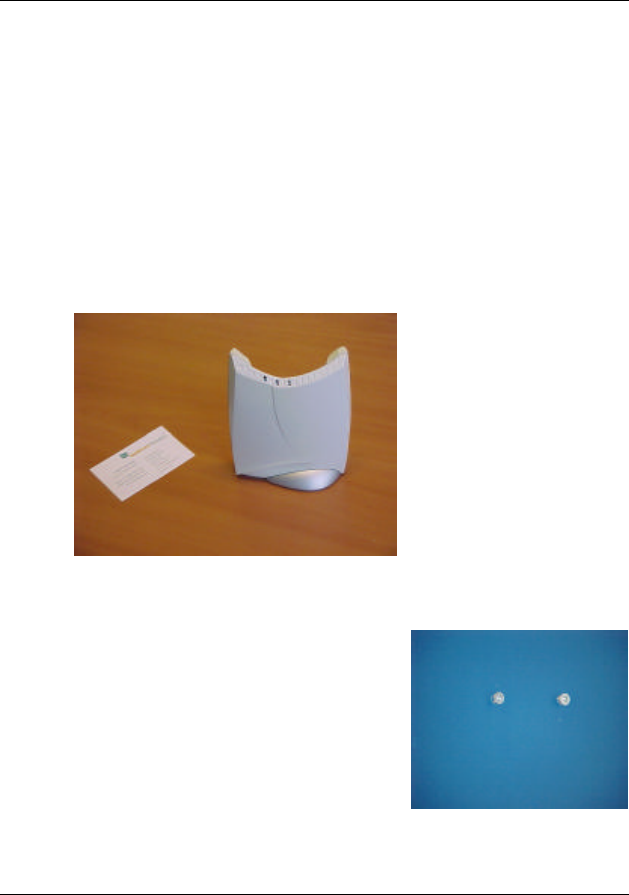
No Wires Needed
Page 12 of 40 11 Mbps WLAN Access Point User manual
3 Installation
1. The AP can be installed in 3 different ways. These are Ceiling mount,
Wall mount, and desktop mount. For each situation there are
brackets available. The foot is typical for the desktop and ceiling
mount, and the bracket is for wall mount.
Important: What ever way you plan to mount the AP, please make
sure the unit is always mounted in vertical position.
2. Desk mount: Click the foot on to the AP.
3. Wall Mount: Position the location you
want to mount the AP. Drill holes for
both mounting screws. Place the wall
bracket against the wall and test if it
fits. Remove the bracket from the wall
again. Place it in its position on the
backside of the housing. In the
backside of the housing a small ‘weak
spot’ is engineered. This spot is not
visible but is located exactly in position
with middle hole of the mounting bracket. The right place of the
mounting bracket is determined by the position where the bracket is
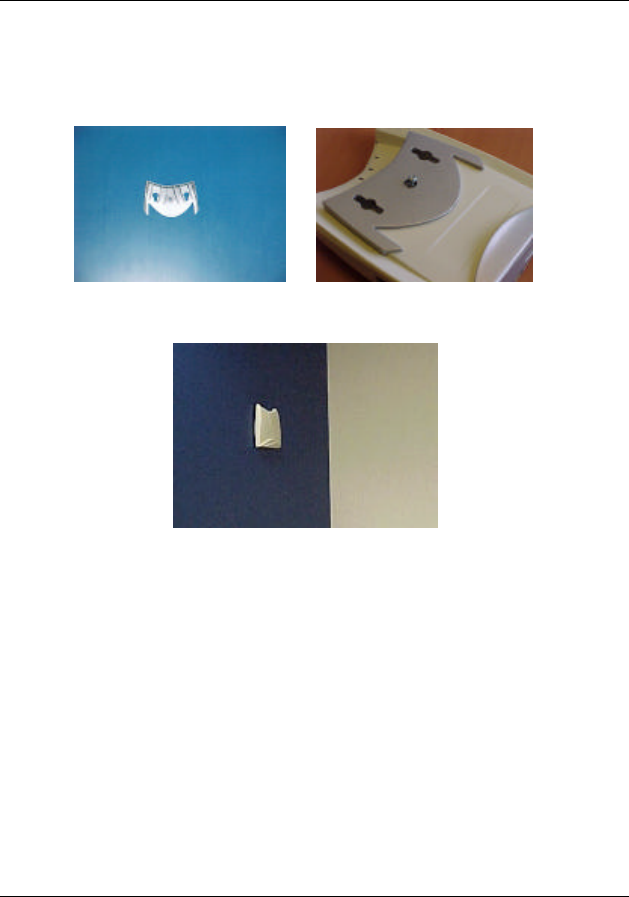
No Wires Needed
User Manual 11 Mbps Wlan Access Point Page 13 of 40
clamped on the housing. If it is not clamped and it needs to be kept
in place, the position of the bracket is wrong. When the right position
is found, put the screw in. Now the unit can be placed on the
predetermined wall position.
4. Ceiling mount: Place the foot on the housing and attach it to the T-
bar bracket.
5. Insert the power connector.
6. Attach the UTP Ethernet cable to the Access Point.
7. Switch on the Access Point.

No Wires Needed
Page 14 of 40 11 Mbps WLAN Access Point User manual
At the front of the Access Point you will see three LEDs.
If all goes well, the rightmost LED (power) is green and the leftmost (WLAN)
and middle (wired network) LEDs flash whenever there is traffic on the
respective networks which is at least ten times per second for the wireless
LAN because of so-called ‘beacons’.
The Access Point automatically selects the medium attached. When no cable
network is detected, the network LED blinks at a constant rate of approximate
3 times per second.
When the supplied power is too low or unstable the power LED will blink at a
constant rate of approximate 3 times per second. All the LEDs will blink at the
same rate if a firmware error is detected.
You can reset the Access Point’s settings to factory defaults by pushing a
paperclip in the little hole next to the Ethernet connector while inserting power
to the Access Point.
When you push a paperclip in the reset hole while the Access Point is
switched on, only the lock set by APCenter™ (Par 4.5) is deactivated.

No Wires Needed
User Manual 11 Mbps Wlan Access Point Page 15 of 40
4 APCenter™ Features
APCenter™ provides a consistent view of the Wireless network. The systems
administrator can use APCenter™ to control a large number of 11 Mbps Wlan
Access Points from a single location. The Access Points are remotely updated
via the SNMP (Simple Network Management Protocol).
Among the supported features are:
• Adding and removing Access Points
• Restricting access to the Wireless network
• Managing data protection options such as IEEE 802.11 WEP 40 and 128,
and AirLock™ Security.
• Assigning radio channels for optimal cell management
• Grouping the wireless network into multiple WLANs with individual access
control and security options
• Programming an Access Point with a specified IP address
• Setting the SNMP Write Community string
• Storing the Access Point configurations on disk
• Printing a summary of your configuration
• Verifying the status of all Access Points in the network

No Wires Needed
Page 16 of 40 11 Mbps WLAN Access Point User manual
4.1 Starting APCenter for the first time
The first time you run APCenter, it will run in wizard mode. After the title
screen, press the Next button to begin configuring your network. The following
screen will appear:
If these settings are correct, press Next to accept them, or if the PC is
connected to more than one network address or the network mask is wrong,
click on Change. The Network Select dialog box appears.
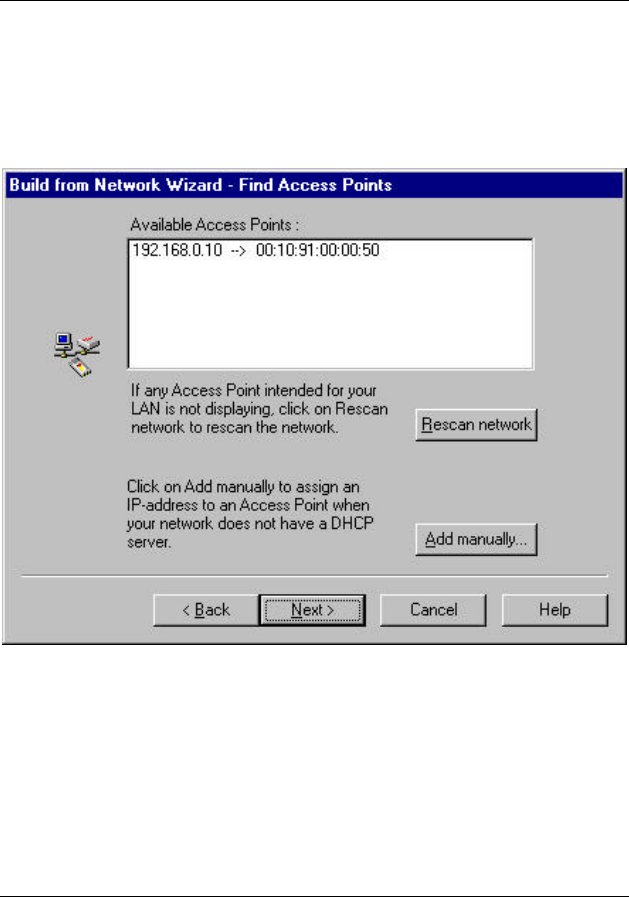
No Wires Needed
User Manual 11 Mbps Wlan Access Point Page 17 of 40
Enter the network settings to be used. Click on OK to return to the Network
Properties dialog box, then click on Next.
The Find Access Points dialog box displays. The APCenter wizard scans for
and displays all available Access Points on the network.
For APCenter to function properly, each Access Point it manages must have a
unique IP address (APCenter uses SNMP to configure and manage the
wireless network Access Points.) If your LAN does not provide either DHCP or
BOOTP Protocol (which automatically assign IP addresses), you will need to
manually assign a valid IP address to each Access Point.
If all Access Points are displayed, click on Next, OR
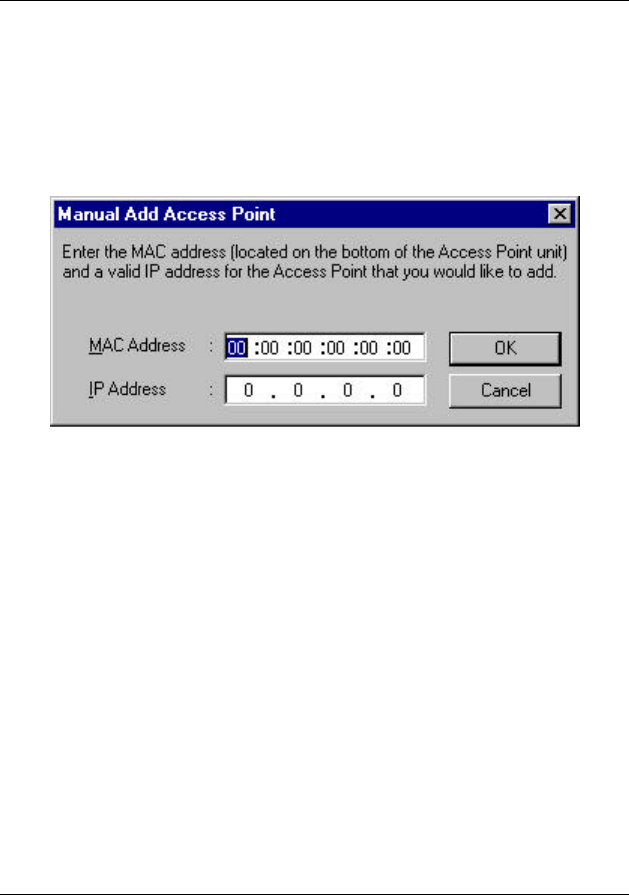
No Wires Needed
Page 18 of 40 11 Mbps WLAN Access Point User manual
If any Access Point intended for your LAN is not displaying, click on Rescan
network to rescan the network for all Access Points. If all Access Points are
now displayed, click on Next, OR
To manually assign an IP address to an Access Point, click on Add manual.
The Manual Add Access Point dialog box displays.
Enter the MAC address (located on the back of the Access Point unit) and a
valid IP address. Click on OK to return to the Find Access Points dialog box,
and click on Next.
The Access Point Settings dialog box displays. It is strongly recommended
that the Network ID (SSID) be changed from the default (‘default’) to an SSID
unique to your network. Only clients and Access Points that share the same
SSID are able to communicate with each other. This screen also allows you to
change the Channel used by the Access Point to transmit and receive
information.
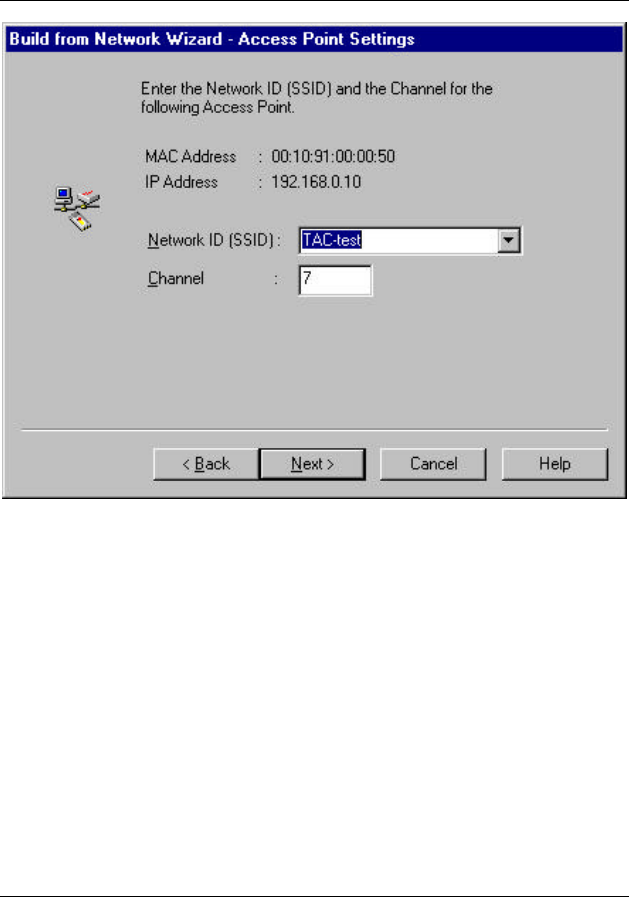
No Wires Needed
User Manual 11 Mbps Wlan Access Point Page 19 of 40
After you set the SSID and/or Channel, click on Next. If your network contains
more than one Access Point, the wizard will display this screen again with the
settings of the next Access Point. When you have set SSIDs and/or channels
for all Access Points on your network, clicking on Next will take you to the
Network Security dialog box.

No Wires Needed
Page 20 of 40 11 Mbps WLAN Access Point User manual
It is possible to encrypt the data on the network using one of two different
algorithms. It is strongly recommended that you enable security.
To enable the WEP security, check the Enable WEP security box and enter a
WEP key in the Key field. Only clients and Access Points that share the same
WEP key are allowed to associate with each other.
To enable No Wires Needed’s much stronger AirLock™ security, check the
Enable 128 bit Airlock Security box. Because the AirLock™ architecture works
with public keys, you do not have to enter keys here. Clients that do not
support AirLock™ will use WEP security if you selected WEP security in this
dialog, or no security otherwise. By checking the Use AirLock Security
Exclusively box, you indicate that clients can only join with AirLock™ security.
The Community String functions as a password for network management,
preventing unauthorized persons from changing the network security and
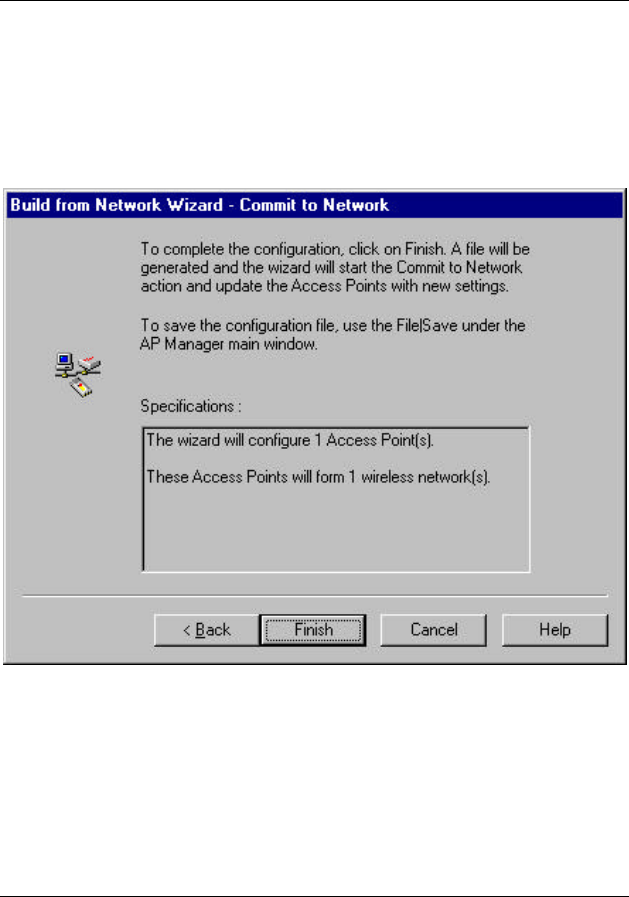
No Wires Needed
User Manual 11 Mbps Wlan Access Point Page 21 of 40
Access Point settings. It is strongly recommended that the Community String
be changed from the default (private).
Click on Next. If more that one Network ID (SSID) is defined on the network,
the wizard will display this dialog box again with the settings of the next SSID.
When you have selected security for all SSIDs on your network, clicking Next
will take you to the Commit to Network dialog box.

No Wires Needed
Page 22 of 40 11 Mbps WLAN Access Point User manual
To complete the configuration, click on Finish. The Commit to Network dialog
box displays. APCenter generates a configuration file and updates the Access
Point with new settings.
Note: The actual settings of the Access Points will not be affected until the
Commit to Network function is executed.
Click on Close after APCenter completes the update.
To save the configuration file you just created, select File àà Save in the
APCenter main window. You can open the saved configuration file anytime
you want to make changes to the network.
To reset to defaults, push a paperclip in the little hole next to the power
connector while simultaneously inserting power to the Access Point. If a
paperclip is pushed in the reset hole while the Access Point is on, only the
lock set by the APCenter is deactivated.
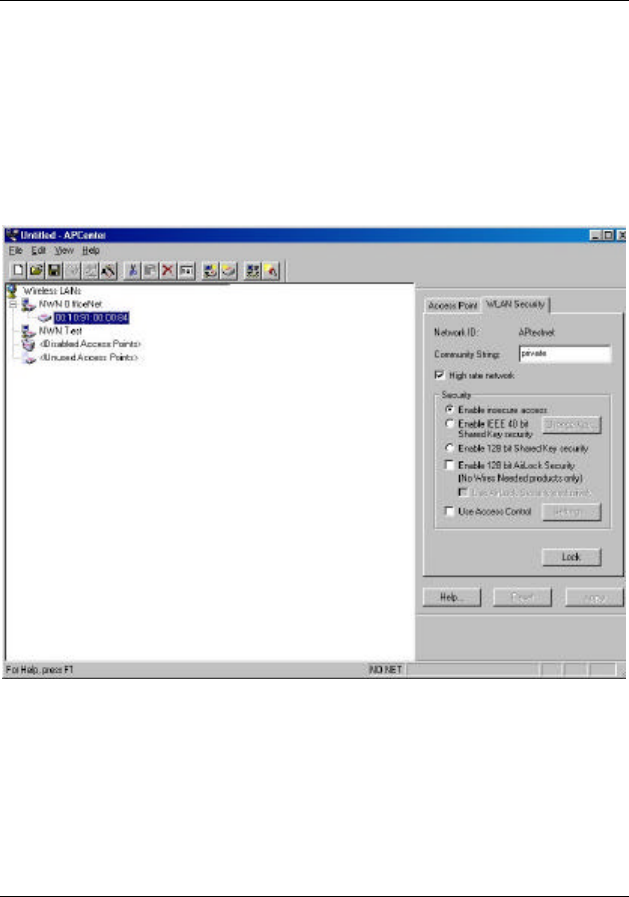
No Wires Needed
User Manual 11 Mbps Wlan Access Point Page 23 of 40
4.2 APCenter™ Main Window
The Main Window of APCenter™ may look like this. Before going into detail it
is good to have an idea of what kind of information to expect.
You may wish to skip to Quick Start to Wireless Networking.
The tree structure on the left of the window shows a list of WLANs (Wireless
LANs) and the Access Points that are part of each WLAN. The sample image
above shows a single Access Point with hardware address 00:10:91:00:00:84
that is assigned to the WLAN named “NWN OfficeNet”. The icons indicate the
status of the WLANs and their associated Access Points.

No Wires Needed
Page 24 of 40 11 Mbps WLAN Access Point User manual
You can use clicking, double clicking, dragging etc. to view Access Point
properties or move an Access Point to another WLAN etc. See Managing
WLANs.
The name (or ESSID) of the WLAN is used for identifying the WLAN. Client
stations can roam freely over Access Points that have the same ESSID.
Therefore the security options for all Access Points with the same ESSID are
identical. Security options can be managed through the WLAN Security
property sheet. See the section on Managing Security.
The Access Point property sheet will mainly be used to select a radio channel
for each Access Point. See Managing Access Points below.

No Wires Needed
User Manual 11 Mbps Wlan Access Point Page 25 of 40
4.3 Quick Start to Wireless Networking
Configuring a Wireless Network for the very first time, involves the following
seven steps:
1. Physically connect the Access Points to the Ethernet LAN. Make sure
they are switched on. The No Wires Needed wireless network will be up
and running immediately. If you are satisfied with the default settings of
the Access Points, you can stop right here. It is more likely however, that
you want to assign different radio frequencies to each Access Point, or
impose some restrictions on the use of your wireless network.
2. To be able to manage the Access Points via SNMP, every Access Point
needs a unique IP address. If you provide a DHCP or BOOTP service on
your LAN (and have sufficient free IP addresses available) this will be
taken care of automatically. If not, please read the section Manually
programming IP addresses.
3. Fire up APCenter™ and configure the Network Settings to reflect your
situation (Use the Edit/Network Settings… menu item). See the section
Network Settings Dialog for details.
4. Create at least one WLAN (Edit/Insert Wireless LAN) and select the
desired security configuration options.
5. Apply the built-in scanning function under Edit/Search Access Points to
collect information about the Access Points. See the section Searching
for Access Points for more information about the scanning function. Drag
the new Access Points to the WLAN of your choice.
6. Select the radio channels of the Access Points according to your cell
plan. See also More about Cells. Add descriptive information about each
Access Point for later reference.
7. Save the configuration information to disk, and commit the new
settings to the Access Points in your network. Using this button.
Note that the actual settings of the Access Points will not
be affected until the Commit to Network function is executed. If you
quit APCenter™, you will be asked to both save and commit.
See Updating Access Point Settings.
You can open the saved configuration file anytime you to make changes to
the network.
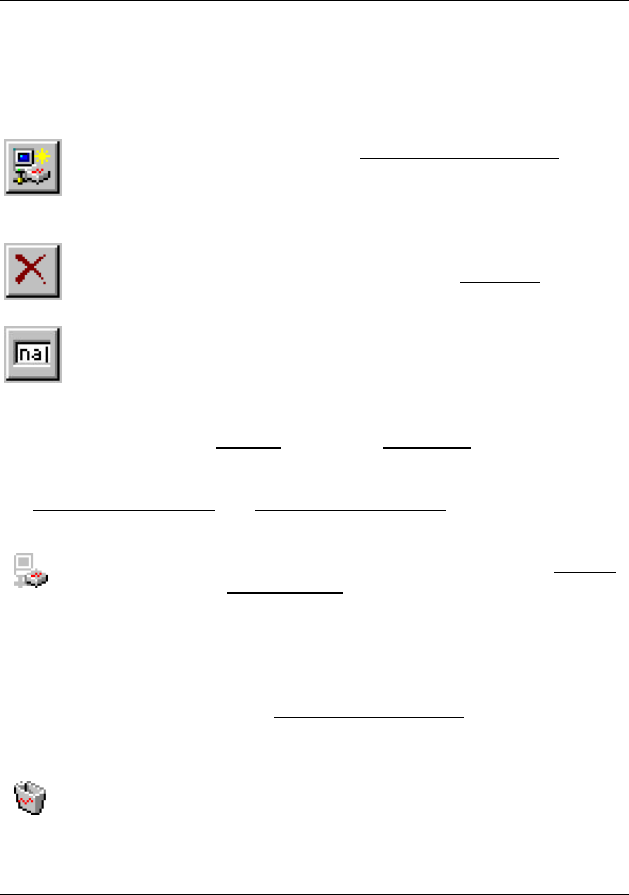
No Wires Needed
Page 26 of 40 11 Mbps WLAN Access Point User manual
4.4 Managing WLANs
A WLAN or “Wireless Local Area Network” consists of a number of Access
Points that together provide seamless access to any wireless stations that are
in reach of any of the Access Points.
Create a WLAN Select the Edit/Insert Wireless LAN menu
item to insert a new WLAN into the list.
Type the name (ESSID) of the new
WLAN.
Destroy a WLAN Remove an empty WLAN by pressing
Delete or selecting the Edit/Clear menu
item.
Rename a WLAN Click on the label of the WLAN to change
its name (ESSID). Note that client stations
use the name to identify the WLAN.
You can move an Access Point from one WLAN to another by dragging it with
the mouse or by selecting Edit/Cut followed by Edit/Paste.
There are two WLANs that have a special meaning in APCenter™. These are
the Unused Access Points and Disabled Access Points special WLAN’s.
Unused
Access Points APCenter™ does not manage the Unused
Access Points within the context of the current
document. In other words, these Access Points
are ignored. You can view some information
about them (e.g. radio channel), but not modify
any of their properties. APCenter™ does not
change the settings of these Access Points
when File/Commit to Network is selected. This is
useful when different people manage different
sets of Access Points.
Disabled
Access Points Access Points that are moved to this folder will
be made inaccessible for any client station as
soon as they are updated.

No Wires Needed
User Manual 11 Mbps Wlan Access Point Page 27 of 40
4.5 Managing Access Points
Individual Access Points are identified by their hardware address (or MAC
address). To insert a new Access Point into the APCenter™ document by
hand, its hardware address must be known. You can search for Access Points
in your network automatically; see Searching for Access Points.
Insert an
Access Point Select the Edit/Insert Access Point menu item to
insert a new Access Point into the selected
WLAN. APCenter™ will ask for the hardware
address of the Access Point.
Disable an
Access Point
Move an Access Point to the “Disabled” special
WLAN by pressing Delete or selecting the
Edit/Clear menu item. Access Points in this
special WLAN will not be accessible for any
client station. See Managing WLANs.
The Access Points are shown with one of the following icons.
On-line The Access Point is accessible on-line.
Off-line The Access Point is currently not accessible, or
the IP address is not known or incorrect.
Locked The Access Point is permanently locked. Its
properties cannot be changed.
Select the Access Point property sheet to view or modify the settings of the
selected Access Point. The main function is to be able to program the Access
Point’s radio channel to match the cell plan. See the section “More about
Cells” for details.
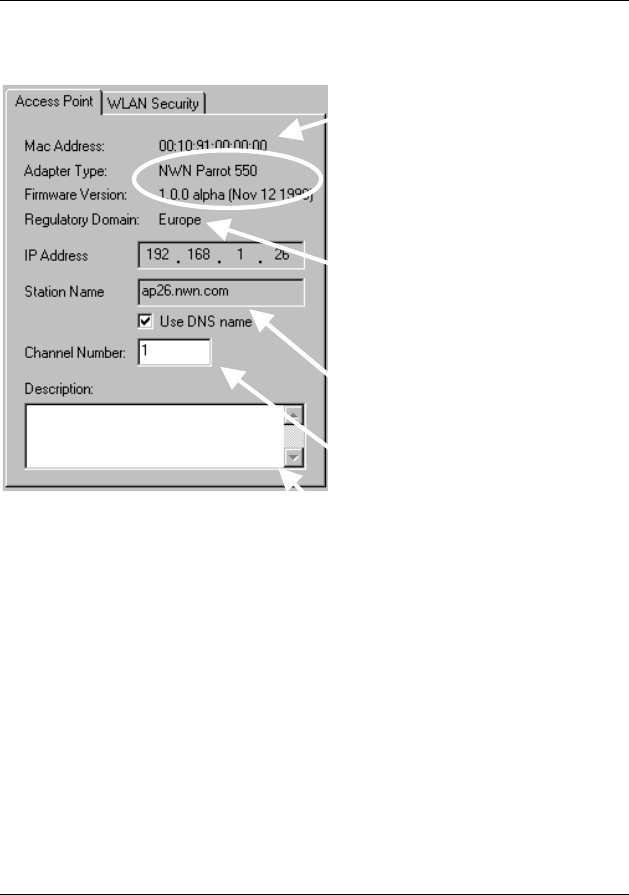
No Wires Needed
Page 28 of 40 11 Mbps WLAN Access Point User manual
Read-only features shown include hardware address, brand and version, and
the regulatory domain.
Hardware address (MAC address)
Brand, type, and version
information.
The regulatory domain for which
the Access Point has been
configured (factory setting). Note
that it is illegal to use the Access
Point outside the designated
domain. See Regulatory Domains
for details.
The IP address and the hostname
of the Access Point.
The radio channel number. The
permissible channels depend on
the Regulatory Domain.
An optional description field for
easy reference.
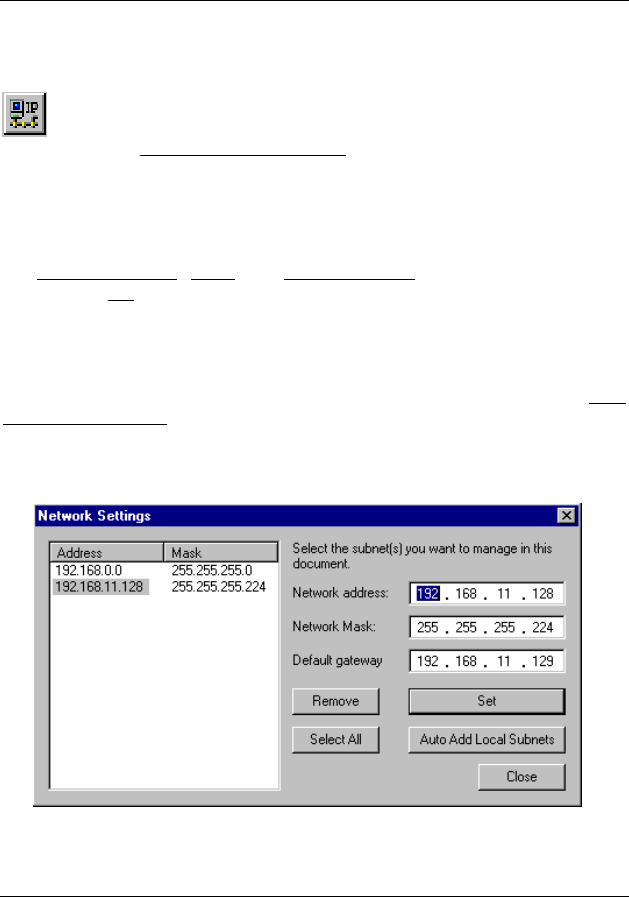
No Wires Needed
User Manual 11 Mbps Wlan Access Point Page 29 of 40
4.5.1 Network Settings Dialog
Selecting the Edit/Network Settings… menu item (or clicking the
corresponding toolbar button) pops up the Network Settings dialog. Use this
dialog to inform APCenter™ about your network configuration. APCenter™
needs this information to be able to scan for Access Points.
Add your network addresses (subnets) by entering the correct information in
the Network address, mask and default gateway fields in the dialog, and
clicking the Set button for each network/subnet. To view the details of a
particular network, click on the Address field in the list. Click the Remove
button to delete a network from the list.
If the computer on which APCenter™ is running is connected to all your
networks directly (this means without routers inbetween), you can try Auto
Add Local Networks to insert them in the list. Note: if subnetting is used, the
network addresses and masks generated by this function may not be correct
and should be adjusted manually.
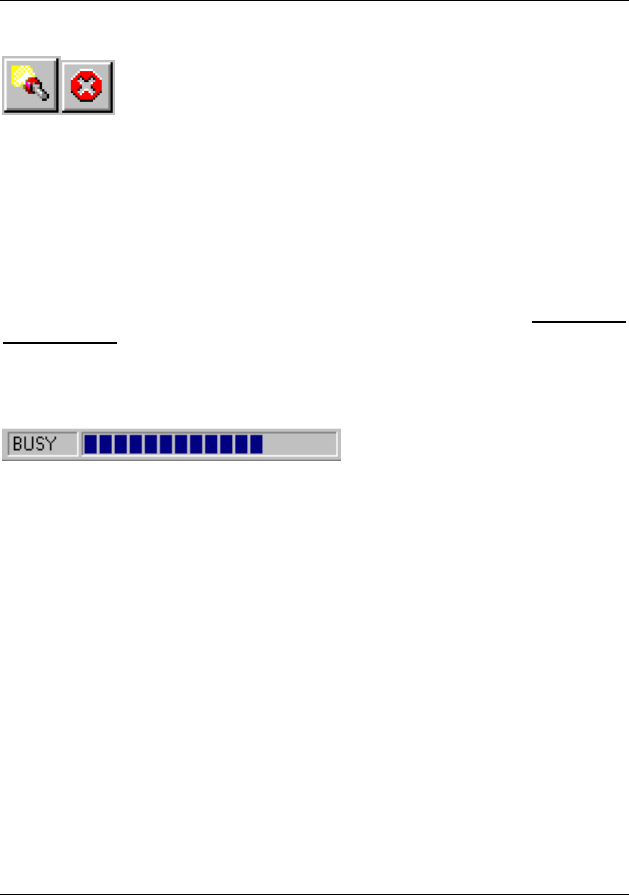
No Wires Needed
Page 30 of 40 11 Mbps WLAN Access Point User manual
4.5.2 Searching for Access Points
APCenter™ has an easy-to-use Access Point discovery function that
simplifies the administration of the Access Points in your network. You
normally apply the Search function in one of the following situations:
• New Access Points have been added to the network
• The IP address of one or more Access Points is no longer valid or known,
possibly because the DHCP or BOOTP server has assigned it a different
IP address. You may be informed of this fact because the Access Points
will be reported off-line by APCenter™.
Invoke the Search function by selecting the menu command Edit/Search
Access Points, or pressing the associated toolbar button. While APCenter™ is
scanning the network; you may continue work on the document. If necessary
you can abort a scan by clicking on the Abort Search button.
A progress indicator will be shown in the status bar.

No Wires Needed
User Manual 11 Mbps Wlan Access Point Page 31 of 40
4.5.3 Manually programming IP addresses
The preferred method of providing IP addresses for your Access Points is
applying a DHCP or BOOTP server in your network. If you do, the Access
Points will acquire an IP address automatically from this server.
If you do not have a DHCP server it is possible to set the IP address of your
Access Points from APCenter™.
1. Physically connect the Access Points and the computer on which you run
APCenter™ to the same Ethernet segment. (Subnet)
2. Make sure there is no DHCP or BOOTP server running.
3. Switch the Access Points on. The network LED should light up in red.
4. Configure the network you want your Access Points to be part of. See
Network Settings Dialog for details. (Subnet Mask, etc)
5. Enter the hardware addresses of the Access Points by hand using the
Edit/Insert Access Point menu command or clicking the appropriate
toolbar button.
6. For each Access Point select Edit/Set IP Address menu command and
enter the required IP address manually. As soon as you press apply, the
Access Point should acquire the designated IP address. Within a few
seconds the network LED on the Access Point should light up green.
Note that you may or may not be able to communicate with the Access
Point, depending on the validity of the IP address in the current Ethernet
segment.
Note: If you skip point 4, you will not be able to find an AP!!

No Wires Needed
Page 32 of 40 11 Mbps WLAN Access Point User manual
4.6 Managing Security
Maintaining security in a wireless LAN environment is somewhat different from
a wired network, because the radio waves do not stop at your office walls.
Eavesdropping or unauthorised access from outside your building can be a
serious threat.
There are three types of actions involved:
• Protecting your data while it is transferred from one station to another.
Encryption techniques will be necessary in most environments (Data
Privacy).
• Control who can make use of the wireless network (Access Control).
• Protecting your network configuration against tampering from both inside
and outside your organisation (Secure Management).
Data Privacy The 11 Mbps Wlan Access Point supports three
different data privacy algorithms: unencrypted data;
standardised IEEE 802.11 WEP (based on a 40 bit
shared key), and No Wires Needed AirLock™ (based
on automatically generated 128 bit session keys).
Access Control The IEEE 802.11 standard allows for Access Control
rules based on the client station’s hardware address,
and is fully implemented by the 11 Mbps Wlan. If
AirLock™ is enabled, the hardware address is also
verified using cryptographic techniques. See the section
on AirLock™ Security Architecture.
Secure
Management The primary protection against tampering for any SNMP
agent is the Write Community String (WCS), which
functions as a password for network management
commands. The WCS is sent over your network in plain
text, making it vulnerable to eavesdropping from within
your organisation. The WCS is never sent over the
radio,however.
If you want you can lock your Access Points. After
being locked they can no longer be managed via
SNMP. Press the pinhole Reset switch on the back-
panel of the Access Point to unlock the Access Point.
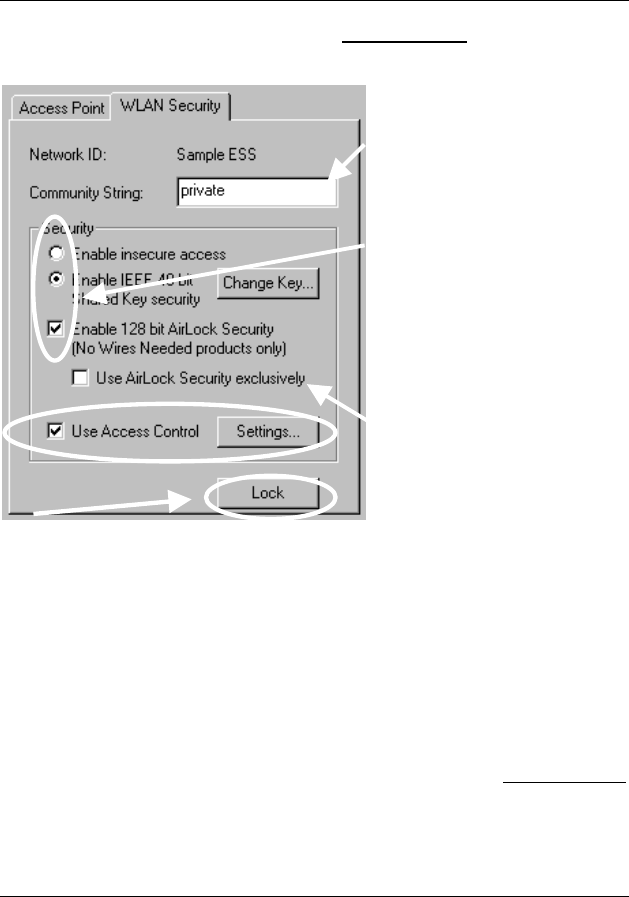
No Wires Needed
User Manual 11 Mbps Wlan Access Point Page 33 of 40
Select the required security options in the WLAN Security property sheet.
Use this button to lock the settings of the
Access Points (almost) permanently
Edit the Community String
field to modify the SNMP
Write Community String for
all Access Points in the
selected WLAN.
Select the data privacy
algorithm(s) you want to
support in the Access Points.
If AirLock™ is selected,
client stations not supporting
AirLock™ may still
communicate with the
Access Points through the
ASBF™ mechanism.
In some situations it may be
advisable to enforce
AirLock™ as the only
available mechanism.
See the section Access
Control for details.
.
4.6.1 Access Control
Within the IEEE 802.11 framework, Access Control is based on the hardware
address of the client stations. Per client you can select whether or not it will be
allowed access to your wireless network infrastructure. On the WLAN Security
tab, check the Use Access Control box to enable Access Control. If this box is
not checked, any client station can associate with your network.
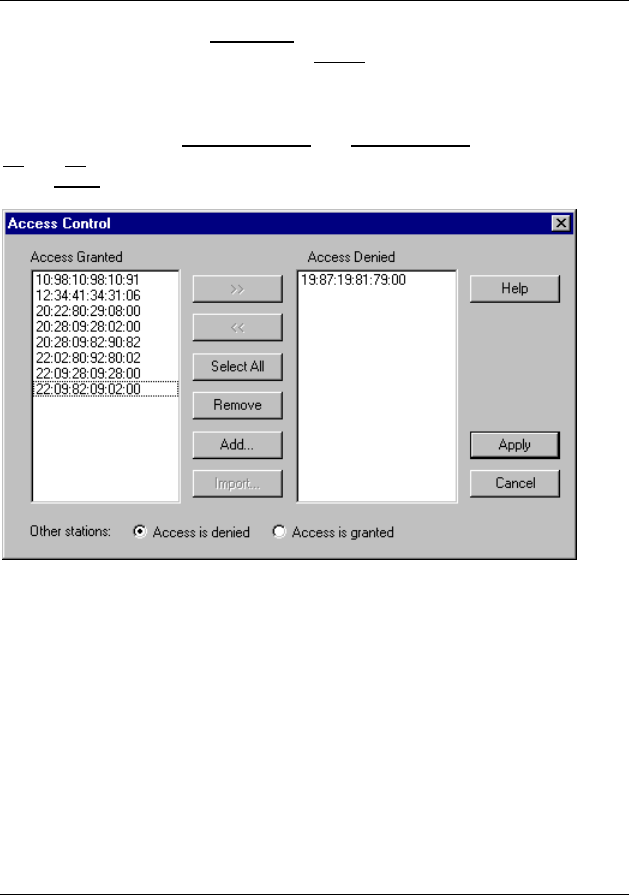
No Wires Needed
Page 34 of 40 11 Mbps WLAN Access Point User manual
Click the Access Control Settings… button on the WLAN Security tab to pop
up the Access Control Dialog. Press Add… to enter the client stations you
want to grant access.
A default rule determines whether unregistered stations can join. You can
move clients between Access Granted and Access Denied lists by clicking the
>> and << buttons or pressing the left and right arrow keys.
Press Apply to confirm your changes and close the dialog.

No Wires Needed
User Manual 11 Mbps Wlan Access Point Page 35 of 40
4.7 Updating Access Point Settings
After modifying the open APCenter™ document you should update the
Access Points in your network with the new settings. This is done for all
Access Points simultaneously by selecting the File/Commit to Network menu
command. Or clicking the associated toolbar button. During the update the
following Dialog is displayed:
Access Point that
is currently being
processed.
Progress indicator
Update result
counters. The
‘Skipped’ count
refers to Access
Points in the
‘Unused’ special
WLAN.
Specific error
messages.
Within 10 seconds after the Access Point has been successfully updated it will
disconnect all client stations that are joined with it, and restart with the new
settings.

No Wires Needed
Page 36 of 40 11 Mbps WLAN Access Point User manual
IEEE 802.11 WEP Security
The IEEE 802.11 standard includes a Shared Key data privacy mechanism,
called ‘Wired Equivalent Privacy’.
Features of WEP are:
• Data encryption using a 40 or 128 bit shared key
• No key distribution mechanism. The shared key (password) must be
distributed manually to all personnel and either be remembered or stored
somewhere on the hard disk.
• Simple authentication of clients based on hardware address.
4.8 AirLock™ Security Architecture
The No Wires Needed AirLock™ Security architecture provides superior
protection of your data combined with improved ease of use through secure
automated key management, while maintaining full compatibility with the IEEE
802.11 standard.
Some features of AirLock™ Security are:
• Data encryption using 128 bit random session keys
• Key management using a public / private key scheme. Keys are never
transmitted as plain text
• Strong authentication of the client stations based on challenge /
response.
• Automatic scale back function (ASBF™) maintains compliance to IEEE
802.11 shared key security for client stations that do not support
AirLock™ Security.
• RC-4 encryption algorithm
4.9 More about Cells
Each Access Point in the network forms the centre of a cell, or BSS. The Cells
should overlap slightly to guarantee seamless wireless connectivity
everywhere. Nearby Access Points should preferably send and receive on
different channels for maximum throughput.
Creating a cell plan for your site can be complicated, and is usually done by
experts employing special measuring equipment.
Furthermore, the radio channels you may use depend on both the capabilities
of the PC-Cards you are deploying, as well as the regulations in your area.

No Wires Needed
User Manual 11 Mbps Wlan Access Point Page 37 of 40
The following table may be of help:
Regulatory
Domain Area Permissible
Channels 11 Mbps WLAN AP
predefined
channels
FCC United States 1 – 11 1, 6, 11
DOC Canada 1 – 11 1, 6, 11
ETSI Europe except
France 1 – 13 1, 7, 13
FRANCE France 10 10
MKK Japan 14 14
4.10 Compatibility
The APCenter™ utility version 3.0.1 is compatible with the No Wires Needed
11 Mbps WLAN Access Points and the series 1100 Parrot Access point only.
The 11 Mbps WLAN Access Point is also compatible with the Swallow 1100
series, for airlock, however, the Swallow 1100 requires an upgrade.
The 1100 Parrot access point also requires an Airlock upgrade in order to
work with an 11Mbps WLAN Pc Card.

No Wires Needed
Page 38 of 40 11 Mbps WLAN Access Point User manual
5 Glossary
AirLock™ Security No Wires Needed BV proprietary security
architecture. AirLock™ Security provides the
following functionality:
• 128 bit data encryption
• secure Access Control based on a
private/public key algorithm
• Integrated automated key distribution
algorithm
See the AirLock™ Security white-paper for
detailed information.
BSS “Basic Service Set”. De facto an alias for Access
Point.
Cell Area in which the radio signal of an Access Point
is sufficiently good to join with it.
ESS “Extended Service Set”. A group of Access
Points with identical settings among which a
client system can roam. An ESS forms the heart
of a WLAN.
No Wires Needed BV http://www.nwn.com
11 Mbps Wlan Access
Point 11/5.5/2.0/1.0 Mbps IEEE 802.11 Access Point
by No Wires Needed BV.
Shared Key Algorithm Encryption scheme for which both sender and
receiver need to know the (same) encryption
key.
SNMP “Simple Network Management Protocol”
11 Mbps WLAN PC Card
11/5.5/2.0/1.0 Mbps IEEE 802.11 Wireless PC
Card by No Wires Needed BV.
WLAN “Wireless LAN” The set of Access Points and
Wireless Clients that form a local area network.
Write Community String SNMP password
WEP “Wired Equivalent Protection”
Data privacy mechanism based on a 40 bit
shared key algorithm, as described in the IEEE
802.11 standard

No Wires Needed
User Manual 11 Mbps Wlan Access Point Page 39 of 40
6 Technical specifications 11 Mbps WLAN AP
6.1 Standards supported
− Compliant with ETS 300 328 and ETS 300 826 (CE marked)
− IEEE 802.11 standard for Wireless LAN
− All major networking standards (including IP, IPX)
6.2 Environmental
Operating temperature (ambient):
− 0°C to 40°C (32°F to 104°F)
Humidity:
− 95%
6.3 Power specifications
DC power supply
− In 230 VAC 50 Hz 150 mA
− Out 5 VDC 2 A
11 Mbps Wlan Access Point
− In 5 VDC 1 A

No Wires Needed
Page 40 of 40 11 Mbps WLAN Access Point User manual
6.4 Radio specifications
Range:
− per cell indoors approx. 50 meters (150 ft) or more
− per cell outdoors up to 300 meters (1000 ft)
Transmit power:
− +18 dBm
Frequency range:
− 2.4-2.4835 GHz, direct sequence spread spectrum
Number of Channels:
− Europe: 13 (3 non-overlapping)
− US: 11 (3 non-overlapping)
− France: 4 (1 non-overlapping)
Antenna system:
− Dual antenna diversity system; 2dB gain
6.5 Specific features
Supported bit rates:
− 11 Mbps
− 5.5 Mbps
− 1 Mbps (IEEE 802.11 DSSS compliant devices, using ASBF™ )
− 2 Mbps (IEEE 802.11 DSSS compliant devices, using ASBF™ )
Data encryption:
− AirLock™ security, 128-bit key length
Utility Software:
− APCenter™ management tool
Key Management:
− Automatic Dynamic Key Allocation (ADKA) through public key
6.6 Physical Dimensions
135x 106 x 20 mm